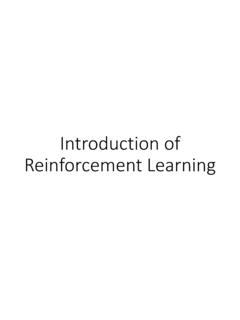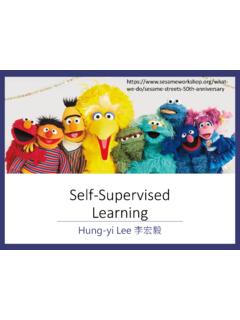Transcription of Machine Learning HW3
1 Machine Learning HW3 ML TAs - Image image classification with convolutional neural the performance with data augmentations. popular image model techniques such as Introduction - Food Classification The images are collected from the food-11 dataset classified into 11 classes. Training set: 9866 labeled images Validation set: 3430 labeled images Testing set: 3347 imagesRules DO NOT attempt to find the original labels of the testing set. DO NOT use any external datasets. DO NOT use any pretrained models. Also, do not attempt to test how effective pretraining is by submitting to kaggle. Pretraining is very effective and you may test it after the competition ends. You may use any publicly available packages/code But make sure you do not use pretrained models. Most code use those. You may not upload your code/checkpoints to be publicly available during the timespan of this : Medium : Training Augmentation + Train Longer Strong : Training Augmentation + Model Design + Train Looonger (+ cross Validation + Ensemble) Boss : Training Augmentation + Model Design +Test Time Augmentation + Train Looonger (+ cross Validation + Ensemble) Baseline GPU Time Estimation All results are benchmarked on kaggleSimple : 15~20minsMedium : Augmentation A - 6hrs Augmentation B - 80 minStrong : Model X + Augmentation B + Resplit- 12 hrs Model Y + Augmentation B + Resplit- 10 hrsModel Z + Augmentation B + Resplit- 6 hrsBoss : Model Z + Augmentation B + TTA + Resplit-12 hrsOr EnsembleModel Y + Augmentation B + TTA + Resplit- 12 hrsModel X + Augmentation B + TTA + Resplit-12 hrsSubmission FormatThe file should contain a header and have the following format.
2 Both type should be strings. Id corresponds to the jpg filenames in test. Follow the sample code if you have trouble with Selection Visit for a list of model structures, or go to timm for the latest model structures. Pretrained weights are not allowed, specifically set pretrained=False to ensure that the guideline is Augmentation Modify the image data so non-identical inputs are given to the model each epoch, to prevent overfitting of the model Visit for a list of choices and their corresponding effect. Diversity is encouraged! Usually, stacking multiple transformations leads to better results. Coding : fill in train_tfm to gain this effectAdvanced Data Augmentation - * + * =Label 0 1 0 1 Advanced Data Augmentation - mixup Coding : In your , __getitem__()needs to return an image that is the linear combination of two images.
3 In your , __getitem__() needs to return a label that is a vector, to assign probabilities to each class. You need to explicitly code out the math formula of the cross entropy loss, as CrossEntropyLoss does not support multiple Time Augmentation The sample code tests images using a deterministic test transformation You may using the train transformation for a more diversified representation of the images, and predict with multiple variants of the test images. Coding : You need to fill in train_tfm, change the augmentation method for test_dataset, and modify prediction code to gain this effect train_tfm test_tfm Pred Pred Pred Pred Pred Pred Pred Pred Ensemble> test_tfm+Test Time Augmentation Usually, test_tfm will produce images that are more identifiable, so you can assign a larger weight to test_tfm results for better performance.
4 Ex : Final Prediction = avg_train_tfm_pred * + test_tfm_pred* train_tfm Pred Pred Pred Pred Pred test_tfm_pred avg_train_tfm_pred test_tfmCross Validation cross -validation is a resampling method that uses different portions of the data to validate and train a model on different iterations. Ensembling multiple results lead to better performance. Coding : You need to merge the current train and validation paths, and resample form those to form new train and validation sets. TrainTrain TrainTrain TrainTrainValidationValidationValidation ValidationEnsembleCross Validation Even if you don t do cross validation, you are encouraged to resplit the train/validation set to suitable proportions. Currently, train : validation ~ 3 : 1, more training data could be Average of logits or probability : Need to save verbose output, less ambiguous Voting : Easier to implement, need to break ties Coding : basic math operations with numpy or torchKaggle TutorialKaggle Introduction Kaggle GPU : 16G NVIDIA TESLA P100 Faster data IO Easier checkpoint reusing Limited to 30+ hrs/week depending on usage.
5 Limited to 12hrs/run We strongly recommend that you run with Kaggle for this homeworkHow to runChange sorting to Recently Run if you can t find the codeHow to get data : In the input section, there should already be data titled ml2022spring-hw3 If there isn t, click on Add data and find ml2022spring-hw3 How to use gpu : Change accelerator to gpu when you run your GPU time is limited, It is advised to NOT utilize GPU while debuggingHow to Run interactively : The commands are very similar to google colabAny output writing to ./ will end up here, you can download itHow to Run in background: Execute code from start to end, all results would be save permanently. (Output is limited to 20G, max run time = 12hrs)Make sure your code is bug free, as any error in any code block would result in early stopping How to view Run in background results You can view your results this wayDon t worry if your run is cancelled , the output will still be your model to become kaggle datasetCreate a new notebook with the output as inputHow to utilize your results +New DatasetHow to train and your code in the output data.
6 And upload it to the submission pageHow to retrain from a your code in the output model and save it as a your dataset into the notebook via Add data your code to load your your code in the output data . and upload it to the submission pageTips and tricksTime management Kaggle will allocate more time for those who have utilized GPU resources in the past week. Time resets every Saturday at 08:00, Taipei Time. => Run any code with GPU on kaggle today (3/4) to get (possible) extra time next week. Time consumption is the sum of notebooks running interactively with gpu and running in background with gpu. Please start earlyTime management You can go over the time limit moderately. Kaggle will not interrupt your code in the background if it is already running. If your time limit is reached, you cannot run any code with > 12 runtime=> 24 runtimeTime management - Parallelization You can run two codes in the background If you are satisfied with your code, utilize this to run multiple random seeds/multiple train validation split/multiple model structures, so you can ensembleA sample procedure for beating the boss baselineThe boss baseline could be beaten with a single model trained on kaggle for 12hrsYour procedure can be ensemble of models with parallelization Train : 12h Train : 12h Train : 12h Train : 12h Train : 12hPredictionSave checkpointEnsemble Predictionmultiple random seedsmultiple train validation splitmultiple model structuresExperimental Tips Augmentation is a must to prevent overfitting.
7 A good augmentation can carry on to the testing phase with Test Time Augmentation. If you build your own network structure and have implemented augmentation, don t be afraid to scale up your model. (Many predefined models structure are huge and perform great) In TA s experiment, model structures with downsampling work better, simply choosing the best performing models on ImageNet according to websites is not always a good idea because pretrained weights are not on Classification Label Smoothing cross Entropy Loss FocalLoss on Optimization Dropout Gradient Accumulation BatchNorm Image NormalizationRunning with Google Colab We strongly recommend that you run with Kaggle for this homework If you would like to use colab, DO NOT store data in your drive and load from there, the input/output is very slow. (store at ./ instead) If you mount your google drive in colab : G-suite google drive now has a storage limit.
8 Since models and data can be large, keep an eye on your used space to prevent your account being suspended. Report QuestionsQ1. Augmentation Implementation (2%)Implement augmentation by finishing train_tfm in the code with image size of your choice. Copy your train_tfm code and paste it onto the GradeScope. Your train_tfm must be capable of producing 5+ different results when given an identical image multiple times. Your train_tfm in the report can be different from train_tfm in your training XOQ2. Residual Connection Implementation (2%)Residual Connection is widely used in CNNs such as Deep Residual Learning for Image Recognition. Residual is demonstrated in the following Source : Residual Connection Implementation (2%)Implement Residual Connections in the Residual_Model, following the graph below. Copy your Residual_Model code and paste it on Gradescope. cnn_layer1 Your Residual_Model should connect like You should only modify the forward part of the modelcnn_layer2cnn_layer3cnn_layer4cnn_l ayer5cnn_layer6fc_layer=ReLU=AdditionSub mission Format train_tfm and Residual_Model are present in colab (scroll to bottom) and kaggle (ML2022HW3 - Report Questions), you only need to modify from our sample and Grading PolicyGrading simple(public)+ pts simple(private)+ pts medium(public)+ pts medium(private)+ pts strong(public)+ pts strong(private)+ pts boss(public)+ pts boss(private)+ pts code submission+2 pts report +4 ptsTotal : 10 ptsCode Submission NTU COOL Compress your code and pack them into.
9 Zip file<student_ID> Your .zip file should include only Code: either .py or .ipynb Do not submit models and data File Size Limit : 25MB Submit the code that corresponds to your chosen submission in Kaggle (One of the best)Report SubmissionAnswer the questions on GradeScopeDeadlines Kaggle, Code (NTU COOL), Report (GradeScope)2022/03/25 23:59 (UTC+8)Rules DO NOT attempt to find the original labels of the testing set. DO NOT use any external datasets. DO NOT use any pretrained models. Also, do not attempt to test how effective pretraining is by submitting to kaggle. Pretraining is very effective and you may test it after the competition ends. You may use any publicly available packages/code But make sure you do not use pretrained models. Most code use those. You may not upload your code/checkpoints to be publicly available during the timespan of this You should finish your homework on your own.
10 You should not modify your prediction files manually Do not share codes or prediction files with any living creatures. Do not use any approaches to submit your results more than 5 times a day. Your final grade x and 0 pt for this HW if you violate any of the above rules, final grade = Fail for repeat offenders Prof. Lee & TAs preserve the rights to change the rules & : code (join competition first) : : us if you have Kaggle Discussion (Recommended for this HW) NTU COOL Email The title should begin with [hw3]









